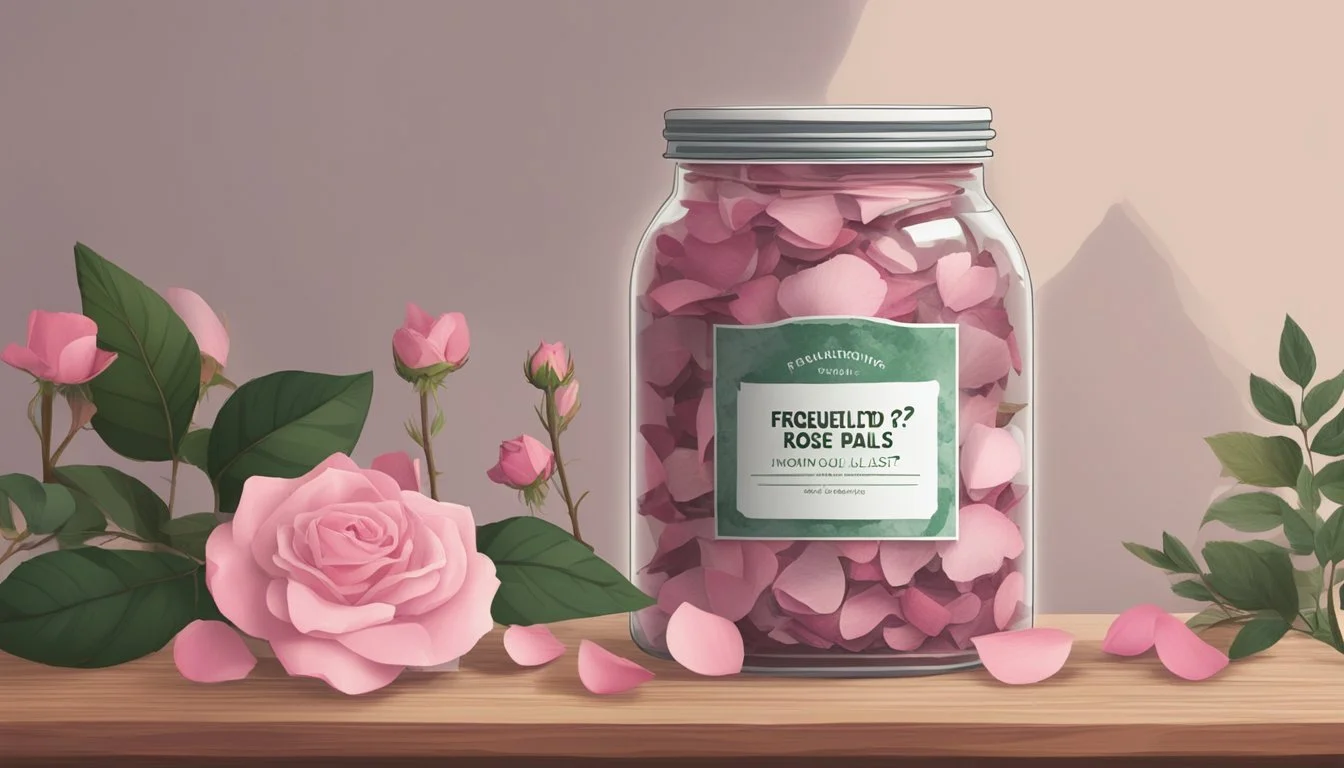How Long Do Dried Rose Petals Last?
Understanding Their Shelf Life and Preservation
Dried rose petals are valued for their prolonged beauty and versatility, serving purposes ranging from decor to crafts. The longevity of dried rose petals significantly surpasses their fresh counterparts, lasting anywhere from one to three years under ideal conditions. Factors such as the method of drying, the environment in which they're stored, and the type of roses used can influence their durability.
To optimize their lifespan, it's essential to store dried rose petals in a cool, dark place to prevent the fading of color and to maintain their delicate structure. Additionally, keeping them away from dampness and humidity will help in preserving their quality over time. As these petals endure, they can be used in a multitude of ways, including in homemade potpourri, as natural confetti or even as ingredients in DIY skincare products.
While dried rose petals offer a timeless charm, understanding the proper techniques for drying and storing them can extend their longevity, ensuring they maintain their aesthetic appeal for years. Whether they originated from a special bouquet or were picked from a personal garden, drying rose petals effectively allows them to continue bringing joy long after a typical rose's bloom has faded.
Benefits and Uses of Dried Rose Petals
Dried rose petals offer an array of applications ranging from home decor to culinary delights, boasting both aesthetic and functional properties. Their enduring color and fragrance make them a versatile choice for various uses.
Decoration and Crafts
Dried rose petals are commonly used for decorative purposes. They provide a vibrant splash of color that can be particularly appealing in:
Weddings: As confetti or for decorating tables.
Crafts: Incorporated into paper making, candle creation, or homemade gift cards.
They retain much of their original color, which contributes to their popularity in crafting and decor, ensuring that the final products have a lasting appeal.
Fragrance and Potpourri
With a natural and long-lasting fragrance, dried rose petals are perfect for creating homemade potpourri mixes. They can also be used in sachets to freshen up drawers and closets. The key benefit is:
A subtle and lasting scent that serves to enhance the ambiance of a living space without overwhelming the senses.
Culinary Applications
Dried rose petals also find their place in the kitchen. They are recognized for their ability to impart a delicate flavor to various dishes:
Inclusion in teas, herbal blends, or as an edible decoration on cakes and pastries.
Their flavor is appreciated for the floral notes they add to culinary creations, and when used sparingly, they do not only contribute aesthetically but also enhance the sensory experience of the dish.
Preparation Methods for Dried Rose Petals
Drying rose petals effectively preserves their color and fragrance for long-term use. Here are several methods to prepare dried rose petals, each suitable for different needs and equipment availability.
Air Drying Technique
To air dry rose petals, one should spread them out in a single layer on a screen or a piece of paper towel. This allows air to circulate around the petals, facilitating even drying. The location should be dry, away from direct sunlight, and have good air circulation. Patience is required, as this method can take several days.
Microwave Drying Method
The microwave method is a rapid technique. Individuals place rose petals between two paper towels in a single layer and microwave them for 30-40 seconds on a normal power setting. The petals should then be left to cool before storage.
Using a Dehydrator
A dehydrator offers a controlled environment for drying rose petals. Petals are placed in single layers on the dehydrator trays, ensuring they are not overlapping. The dehydrator is set to a low heat, and petals typically dry within a few hours.
Pressing Method
The pressing method involves placing rose petals in a flower press or between pages of a heavy book lined with paper towels. Pressed petals are not only dried but also flattened, which makes them ideal for crafting projects or as bookmarks.
Conventional Oven Drying
Oven drying is another option, where rose petals are spread out on a baking sheet in a single layer and placed in an oven set to the lowest possible temperature. Users should keep the door slightly open to allow moisture to escape and check on the petals frequently to prevent burning.
Best Practices for Drying Rose Petals
Preserving the beauty and scent of rose petals through drying requires attention to detail right from the selection of roses to the completion of the drying process. Different methods can yield varying results in the longevity and quality of the dried petals.
Choosing the Right Roses
One should select fresh roses at their peak bloom where the petals are vibrant and undamaged. Morning is the best time for harvesting rose petals, as they should be free from dew. It's important that the roses have not been exposed to harsh chemicals, ensuring their natural beauty and scent are preserved.
Pre-Drying Preparation
Before beginning the drying process, it's crucial to prepare the roses:
Remove individual petals carefully, or keep blooms intact based on the desired result.
Check for and eliminate any residual dew on the petals by patting them gently with a paper towel.
Remove the stems and leaves, as these parts can prolong the drying time and may not preserve as well.
Optimizing the Drying Process
For ensuring the longevity of dried rose petals, the following points must be considered:
Silica Gel Method: Lay the petals in a single layer in an airtight container and cover them with silica gel to maintain the shape and color.
Air Drying: Hang bunches upside down in a warm, dry area away from direct sunlight, or place individual petals on a screen in a single layer.
Desiccants: Utilizing agents like silica gel can accelerate drying and preserve the flower's color and shape.
Shade Drying: Rose petals should be kept away from direct light to prevent color fading, ensuring they are dried in the shade.
By adhering to these best practices, one can effectively preserve rose petals, extending their use far beyond the natural bloom period.
Storage and Shelf Life of Dried Rose Petals
Preserving the beauty and fragrance of dried rose petals hinges on proper storage techniques and understanding their expected shelf life.
Ideal Storage Conditions
To ensure dried rose petals retain their quality, they should be stored in a dry, dark place, away from moisture and light which can degrade their color and scent. A glass jar or any airtight storage container is optimal to prevent exposure to air which could render the petals brittle and lessen their aromatic properties.
Location: Cool, dark cupboard or pantry
Container: Airtight, preferably opaque
Humidity: Low to prevent moisture accumulation
Shelf Life Expectancy
Under ideal conditions, dried rose petals can last for a considerable amount of time. When stored correctly, they can maintain good condition for up to 1 to 3 years. It is essential to periodically check for any signs of degradation or moisture, which might shorten their lifespan.
Factors Affecting Longevity
Several factors contribute to the longevity of dried rose petals:
Light: Excessive light can fade the petals' color.
Moisture: High humidity can introduce moisture, making them prone to mold.
Temperature: Fluctuating or high temperatures can hasten the loss of essential oils.
Air: Limited air exposure helps maintain fragrance and prevents them from becoming too dry.
By adhering to these storage recommendations, one can prolong the shelf life of dried rose petals, using them effectively in various applications like cosmetics, potpourris, and crafts.
Creative and Practical Uses of Dried Rose Petals
Dried rose petals possess enduring beauty and provide a multitude of creative and practical applications that enhance decorations, crafts, and culinary experiences. They offer an ideal balance of natural fragrance and color that can be leveraged in various settings.
Wedding and Event Decor
Dried rose petals are a popular choice for adding a romantic and elegant touch to weddings and special events. They can serve as:
Table Confetti: Scatter petals across reception tables for a colorful accent.
Aisle Runners: Line the walking path with petals to create an enchanting entryway for the bride and bridal party.
The petals' lasting color and delicate fragrance contribute to a memorable atmosphere without the worry of wilting that fresh petals might have.
Homemade Crafts and Sachets
For those who enjoy crafting, dried rose petals provide an excellent material for:
Sachets: Fill small pouches with petals to create natural air fresheners.
Potpourri: Mix petals with other dried flowers and spices to craft a homemade potpourri blend.
These crafts not only decorate and add fragrance to spaces but also make thoughtful, handcrafted gifts.
Culinary Enhancements
For the adventurous cook, dried rose petals can offer unexpected flavor and aesthetic appeal, such as:
Edible Decor: Sprinkle on desserts or salads for a splash of color and a hint of floral flavor.
Infusions: Steep petals in syrups or jams to incorporate their subtle rose essence into various recipes.
When used in cooking, it's essential to ensure the dried petals are culinary-grade and free from any pesticides or chemicals.
Safety and Allergic Reactions
When considering dried rose petals, it is important to be aware of potential allergens and the proper ways to handle and use these delicate flowers to prevent negative reactions and ensure safe use.
Identifying Potential Allergens
The primary concern regarding allergies with dried roses is their pollen, although it is not typically airborne. Individuals with sensitivities to flowers might experience reactions when in close proximity to roses or when handling them. Additionally, rose oil, often used in perfumes and cosmetics, can cause allergic reactions in some people. It is important to know one's allergies and take note of any adverse reactions when coming into contact with rose-related products.
Proper Handling and Use
To mitigate the risk of allergic reactions, individuals should handle dried rose petals with care and avoid direct inhalation if prone to floral allergies. Handling these petals can also expose individuals to pesticides, which may be present if the flowers were treated during growth. It is advisable to source petals from organic roses to reduce this risk. When using rose petals, especially in large quantities for events, ensure they are stored correctly:
Dry Place: Keep petals away from moisture to prolong their lifespan.
Avoid Direct Sunlight: Store petals in a location that does not receive direct sunlight to prevent fading and degradation.
Handling: Use gloves if sensitive to rose oil or potential pesticide residue to limit skin contact.
By understanding and recognizing potential allergens and following proper handling protocols, people can safely enjoy the beauty of dried rose petals.
Frequently Asked Questions
In this section, readers will find specifics on preserving dried rose petals, maintaining their color and scent, and their use in skincare routines.
Preservation Techniques
Dried rose petals can last up to a year when stored properly. The key to extending their longevity lies in the preservation method and subsequent storage. Two common techniques are air-drying and the use of a dehydrator. For air-drying, it's important to arrange the petals in a single layer in a dry, warm, and dark space, allowing air to circulate freely around them. When using a dehydrator, following the manufacturer's guidelines ensures even and consistent drying.
Retaining Color and Scent
The vibrancy of color and strength of scent in dried rose petals are influenced by the drying process and storage conditions. To retain the natural color and prevent fading, petals should be kept out of direct sunlight. Storing them in an airtight container and including a desiccant packet helps to maintain the scent. Additionally, rose water (how long does rose water last?) distilled from the petals can be used as a natural fragrance enhancer.
Using Dried Petals in Skincare
They incorporate dried rose petals into skincare products for their natural benefits. These petals can be ground into a fine powder and added to facial masks for their soothing properties. The petals also infuse oils and create rose water, providing a gentle and natural option for toning the skin. It's essential to ensure that the petals are completely dry to prevent the introduction of moisture, which can lead to spoilage in skincare formulations.
Conclusion
Dried rose petals offer an enduring reminder of the rose's beauty, with a lifespan that can extend for many years. The longevity of dried roses is influenced by several crucial factors:
Method of Preservation: Petals preserved using desiccants like silica gel retain their color and shape longer than those dried by air.
Environmental Conditions: Dry, dark conditions are ideal. Exposure to moisture or sunlight can significantly shorten the petals' lifespan.
Care and Handling: Gentle handling and minimal contact reduce mechanical damage, preserving the roses' appearance for longer periods.
One can generally expect dried roses to last from 1 to 3 years, with proper care extending this range. To optimize their longevity, these practices are recommended:
Store in a cool, dark place.
Use airtight containers for storage, if possible.
Employ UV-protective spray to shield petals from light damage.
Ultimately, dried rose petals remain a charming and lasting decorative option, provided they are cared for with attention to the factors listed above.









